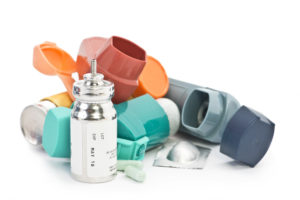This is a three-part series. In Part 1 I covered allergies. In Part 2 I focused on four foods associated with cutting your risk of allergy in half and improving allergy symptoms. In this part, I will discuss asthma.
Asthma, chro nic inflammation of the airways, causes coughing, chest tightness, wheezing or shortness of breath. Nearly 19 million American adults and 7.1 million children battle the disease, with more people added to that number every year.1
nic inflammation of the airways, causes coughing, chest tightness, wheezing or shortness of breath. Nearly 19 million American adults and 7.1 million children battle the disease, with more people added to that number every year.1
Asthma is hereditary. For me, it’s also personal. In my family, I suffer, as did my mother and grandmother. Like those in the rest of my family, my form of asthma is mild. Yet, from time to time it still tries to gain control over my emotions and my body.
However, I am thankful that while I can number myself among the 14.2 million asthma patients who visit a doctor annually for the condition, it hasn’t brought me to a hospital. (In fact, I now visit my doctor less often because I am much better.)
As many as 1.3 million people seek help for their asthma at hospital outpatient departments. There are at least 439,000 hospitalizations and 1.8 million emergency room visits annually, as well.2 All of that costs our economy an estimated $56 billion a year.3
The triggers for an asthma attack are many. They can include exposure to an allergen such as ragweed, and other pollen, animal dander or dust mites; irritants in the air such as smoke, chemical fumes or strong odors; or extreme weather conditions such as extremely dry, wet or windy weather. Exercise or an illness, especially an upper-respiratory illness, can also contribute to an attack.
The American College of Allergy, Asthma, and Immunology lists numerous treatments for asthma. These include: monitoring the disease with a peak flow meter; identifying and avoiding allergen triggers; using drug therapies including bronchodilators and anti-inflammatory agents; and developing an emergency plan for severe attacks.
In addition, there are many medications to treat the symptoms of an attack, keeping the risk of dying from an attack close to 1 percent.
There is no cure.
For those who suffer from them, asthma attacks can be scary. Our bodies naturally respond with fear when our survival is threatened. To make matters worse, for some, the symptoms seem to appear from thin air. One minute the person is fine, the next, gasping.
Someone once said an asthma attack is “like breathing through a straw with an elephant on your chest.” Others cough or feel like they are suddenly submerged in water and trying to breathe. Some people wheeze as they breathe out, or in.
Knowing that this gasping can literally suck the life out of you compounds the problem.
Nevertheless, there is hope for asthma sufferers. Inexplicably, most expert sources omit this hope, as they list the treatments and medications for asthma. The hope is diet.
While not a cure, many studies have shown decreased asthma symptoms through dietary changes, some very simple. This translates into more days breathing freely. (But if you try any of these, please do not decrease or stop your asthma medication without your doctor’s approval.)
For example, one study showed that eliminating two teaspoons’ worth of sodium from one’s daily diet can significantly improve lung function.4
In children, who suffer from asthma at a higher rate, high vegetable intake, has been found to be “protective,” actually cutting their odds of allergic asthma in half.5
In addition, “fruit showed a consistent protective association … for current and severe wheeze and in … adolescents” and for current and severe asthma, allergies and eczema in children.6
In another study, researchers studied 35 patients who suffered from severe asthma for an average of 12 years. They had all been receiving long-term medication, including cortisone. In the study, they ate vegan food for a year, and in “almost all cases, medication was withdrawn or drastically reduced,” with “a significant decrease in asthma symptoms.”7
In addition, ginger is showing great promise against asthma in lab studies.
So there is hope. Today. Next time you have an asthma attack, put down the salt shaker (and high-sodium, processed foods) and take your medicine. When you’re feeling better, think about ways you can incorporate more fruits and vegetables into your diet.
If you want some help with that, consider joining the WholeBlue Eating course during the next enrollment period.
References
1. Asthma Facts: CDC’S National Asthma Control Program Grantees (CDC)
2. AsthmaStats – Asthma-related Missed School Days among Children aged 5-17 Years (CDC)
3. Asthma Management and the Allergist: Better Outcomes at Lower Cost (ACAAI)
4. Thorax. 1993 Jul;48(7):714-8.
5. Pediatr Pulmonol. 2012 Dec;47(12):1159-69. doi: 10.1002/ppul.22576. Epub 2012 May 24.
6. Thorax. 2013 Apr;68(4):351-60. doi: 10.1136/thoraxjnl-2012-202285. Epub 2013 Jan 14.
7. J Asthma. 1985;22(1):45-55.

Sorry, comments are closed for this post.